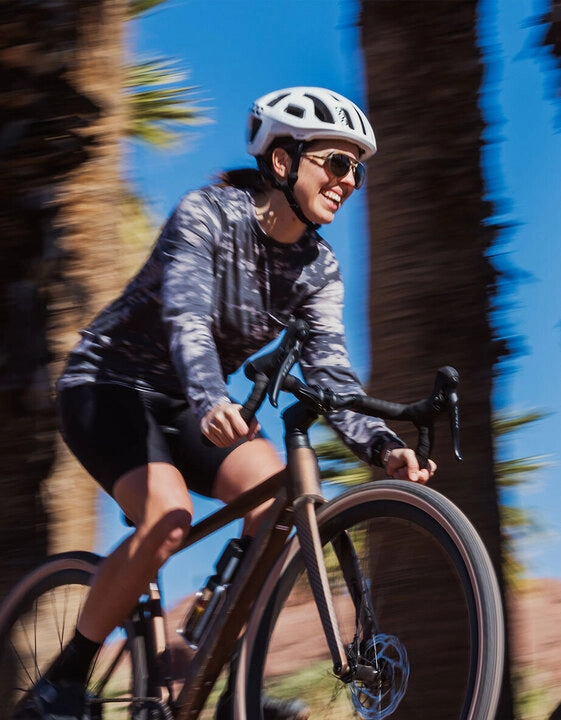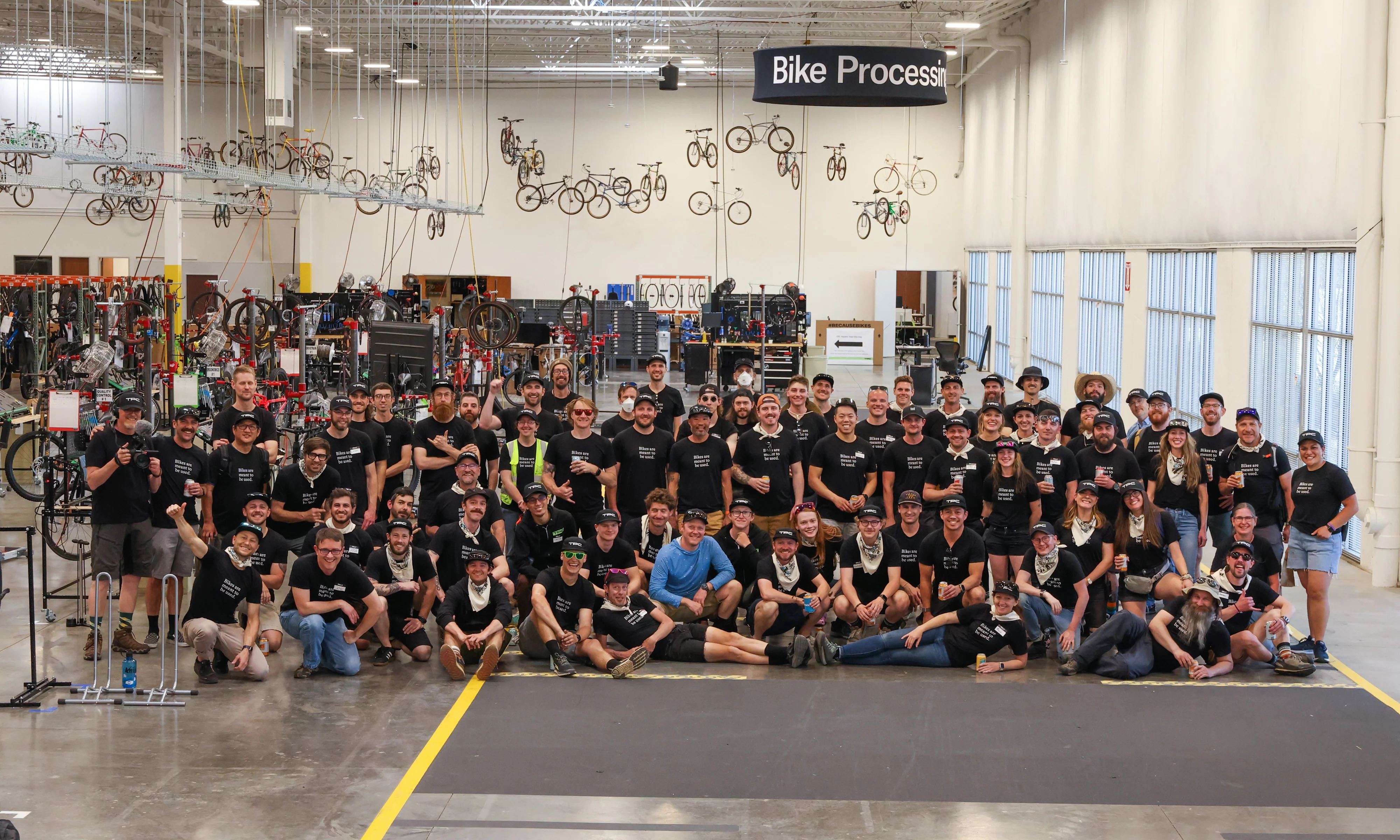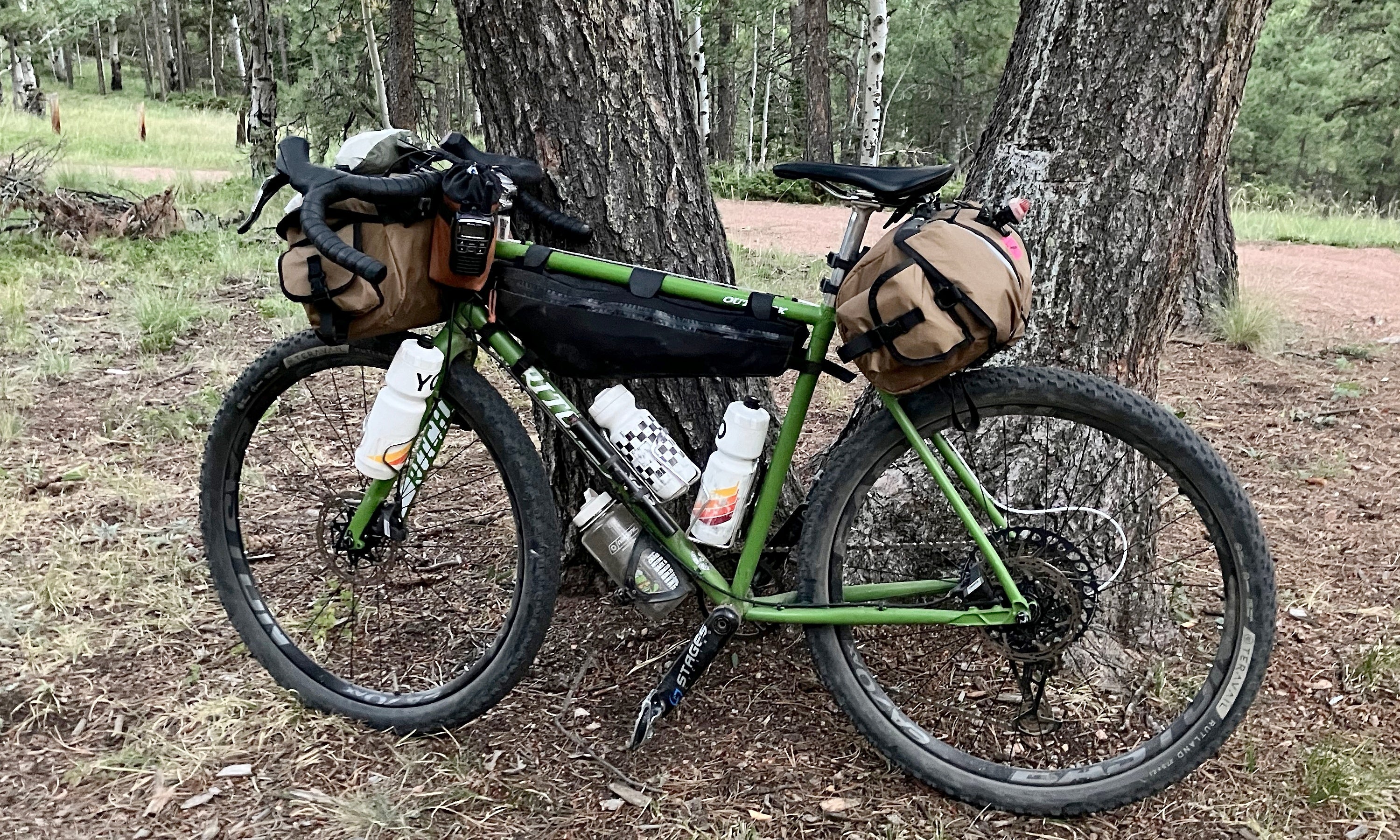If you’re doing Unbound Gravel or any gravel race/event/ride where you care about performance, it’s no exaggeration to say that tire choice is the single most important decision of your setup. Tires have the biggest influence on how your bike performs and feels. If you hypothetically could only spend money on one new upgrade, it should be your tires.
I’m going to cover what I consider the best gravel tire options for Unbound and beyond, why I like them, and what I’m probably going to run on race day this year.
How To Choose a Gravel Race Tire
There are 6 key characteristics to look at when comparing gravel (or really any) bike tires:
- Rolling resistance
- Puncture protection
- Width
- Traction / Tread pattern
- Weight
- Price
No single tire can be the best in class for all 6 of these characteristics. There are always going to be tradeoffs. For riders who care about speed and performance though, the biggest traits worth paying attention to are rolling resistance vs. puncture protection.
Rolling Resistance vs. Puncture Protection
 Some of the rough stuff on Unbound's North course.
Some of the rough stuff on Unbound's North course.
A fast-rolling tire can make a huge difference in your performance, especially over a race as long as Unbound. It features rolling hills, so it’s not flat, but there are no ultra-long climbs. It’s possible to hold a decent speed for long periods and stay with fast groups so having a fast tire is a major benefit.
On the flip side, the terrain at Unbound is notorious for shredding tires. They call it the Flint Hills because the gravel contains a lot of flint rock, which was used by the natives to make arrowheads, so it can get pretty sharp.
A lot of the roads there are also quite remote, so they aren’t well maintained. There are plenty of big holes, ruts, and rocks that you can hit. In some sections, the rocks can get to golf ball or even softball size. The creek crossings also tend to hide holes or rocks that can snipe your tires.
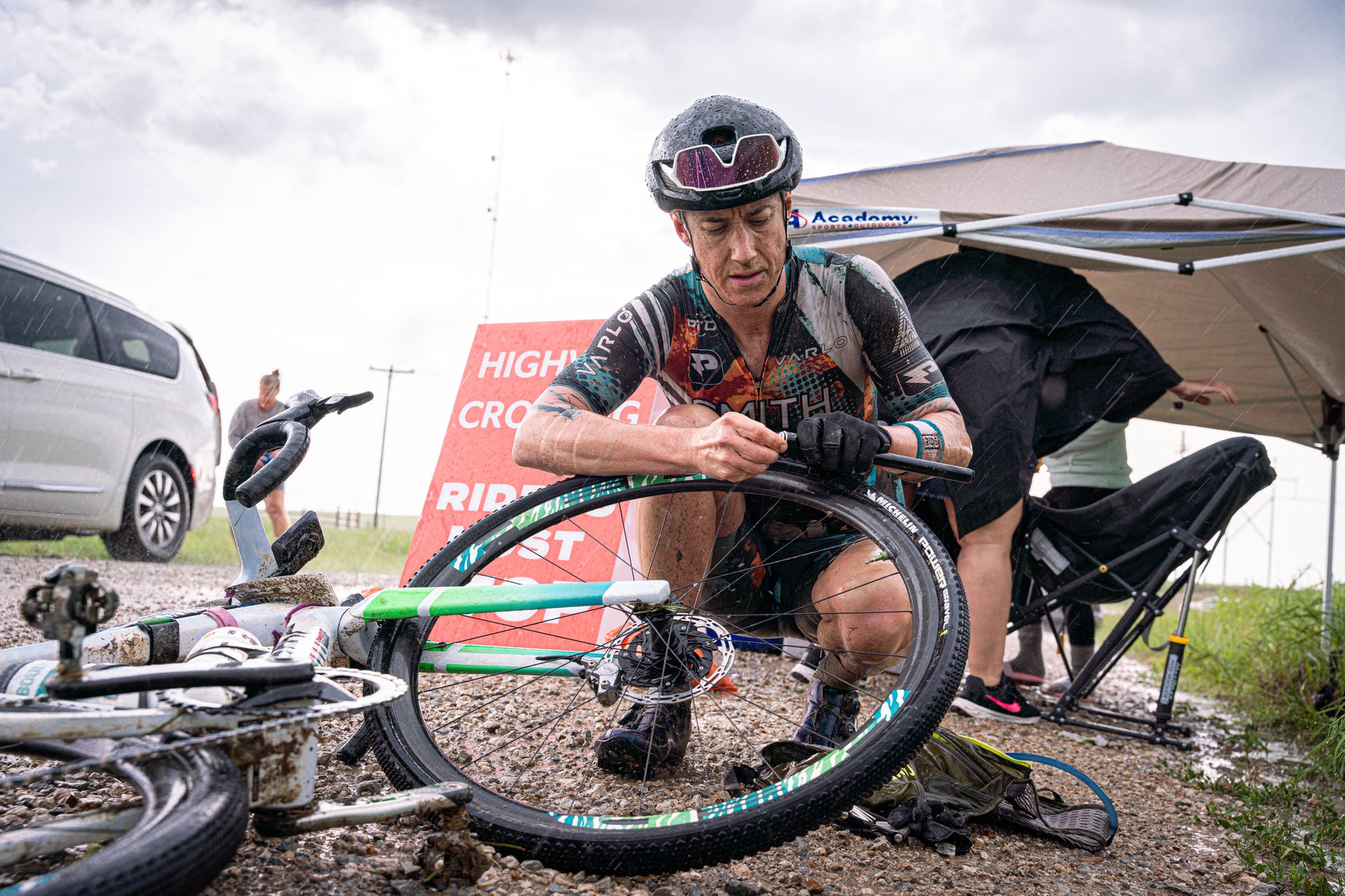
Flatting is no fun.
Faster tires tend to have suppler casings that are easier to puncture. Having the fastest tire available doesn’t matter if you puncture and lose time fixing it. The key then is to pick a tire with the right balance between rolling resistance and puncture protection.
Rolling resistance and puncture protection are hard to measure for the average rider. If you’re a tire geek, you may have looked at bicyclerollingresistance.com before. It has a lot of data that you can use to compare different tires. The testing protocol isn’t perfect and some will critique it for not representing real-world conditions, but right now, it’s probably the best resource regular people have to compare these two characteristics, so it’s what I use.
Tire Width
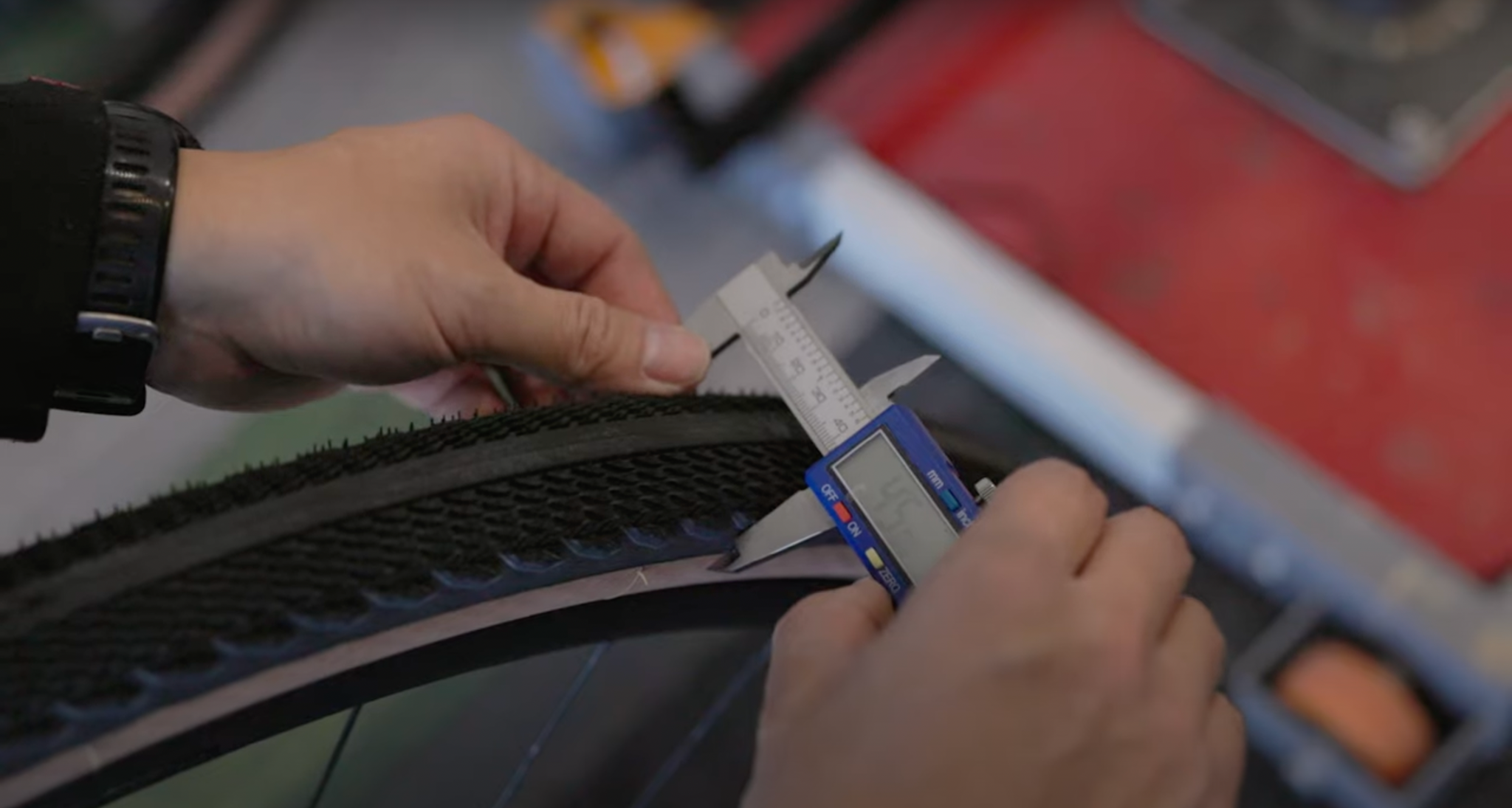
Almost always, my suggestion is to just run the widest tires your gravel bike can clear, For most modern bikes, that’s a tire between 40-45mm wide. For the south course at Unbound, most riders will likely be fine on a 40mm tire. The north course is rougher though, so I’m going to size up a bit to a tire that is 45mm+. Wider tires allow you to run lower pressures, and they will provide more comfort, traction, and confidence.
Traction / Tread Pattern
I like running a fairly low-profile tread that will roll slightly faster than a super knobby tread. There’s not any technical single track and I don’t think anything at Unbound is gnarly enough to need a super aggressive and knobby tire.
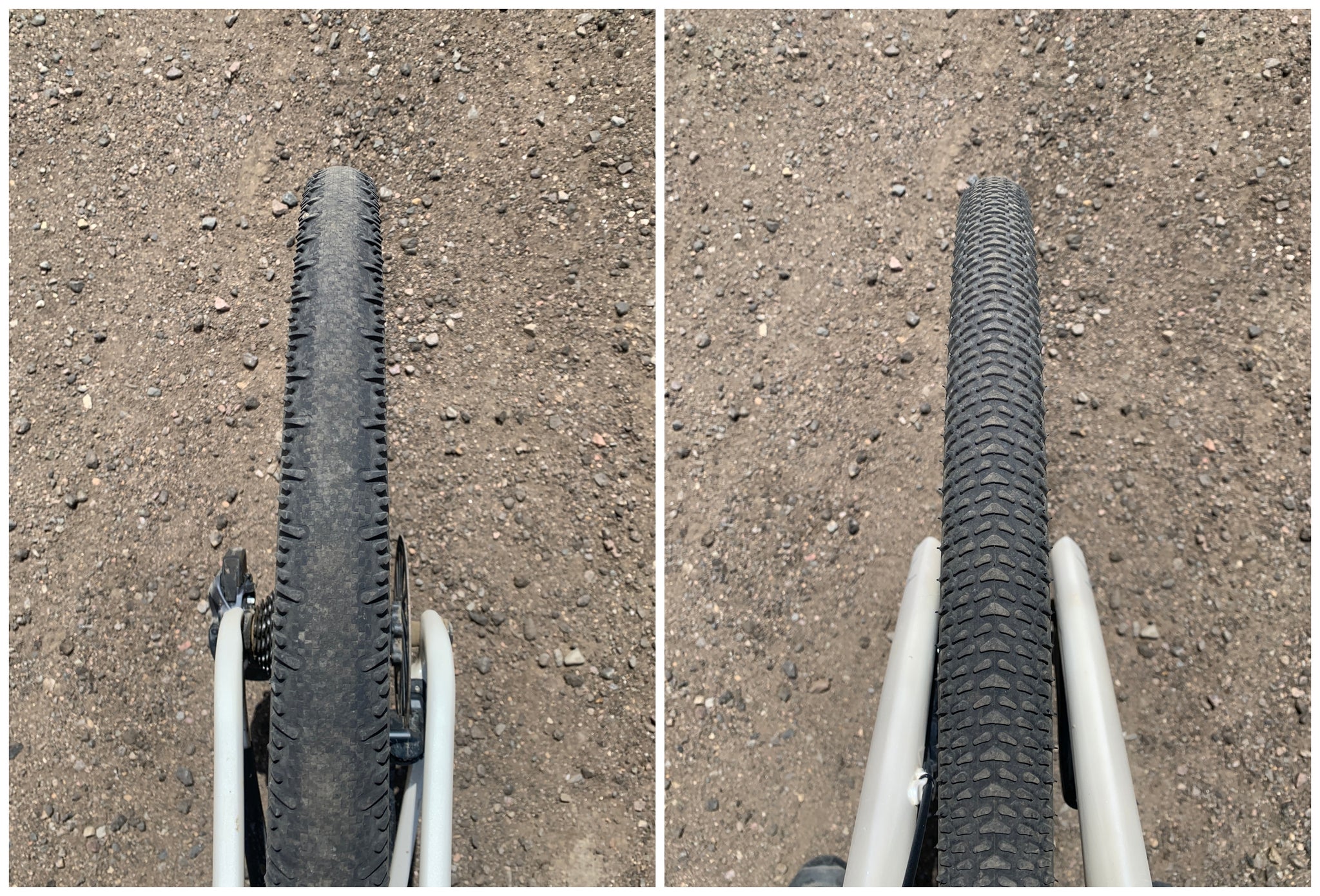 Last year I tested a Schwalbe G-One RS and the rear and a grippier G-One R on the front.
Last year I tested a Schwalbe G-One RS and the rear and a grippier G-One R on the front.
That said, if you’re not super confident on loose gravel turns or descents, then you could consider a slightly knobbier or more aggressive front tire which will give you some extra braking and cornering traction. You can keep a smoother, faster rolling tire on the back, where low rolling resistance will make the biggest difference.
I do this on my mountain bikes, and I’ve suggested mixing tread patterns before. I’m not doing it now though because having the same tire front and rear makes it easier to get by with just one spare tire. I’ll be bringing a spare with me to Emporia just in case anything goes wrong on my preride or I need to swap a tire at a checkpoint.
Weight
I wouldn’t pay that much attention to weight. All the tires that I think are worth considering are pretty close in weight (~500-600 grams). I’d save the weight considerations for smoother or more climb-heavy races like Steamboat Gravel.
Price
A high-quality gravel race tire is usually going to run in the range of $60-90 per tire. Sometimes the best tires are the ones you can afford.
My Top Unbound Gravel Race Tires
I’ve tried A LOT of gravel tires over the last 7 years. There’s been winners and losers. For this post, I’ve narrowed it down to a few tires that I would consider great options for Unbound, and gravel racing in general. The key elements again, are that they roll fast, have decent puncture protection, come in a ~40-45mm width, and I think they handle well on loose and chunky surfaces:
- Specialized Pathfinder Pro
- Challenge Getaway XP
- Continental Terra Speed
- Schwalbe G-One RS
- Maxxis Rambler
I’m Not Using My Old Favorite This Year
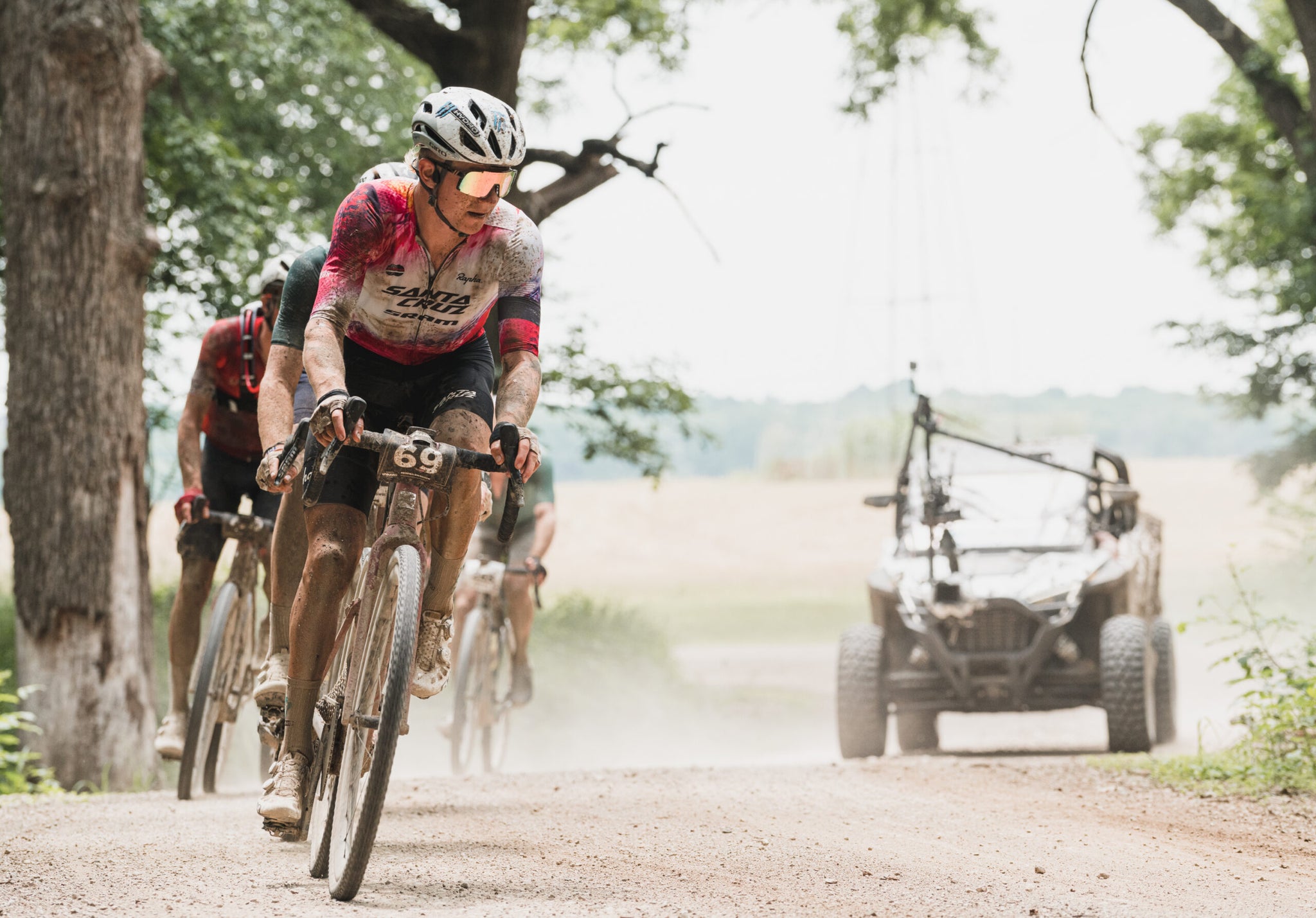
Riders like Keegan Swenson (pictured), Ted King, and Kaitie Keough have won Unbound on the Rambler. Photo: Maxxis

Maxxis Rambler Tire 700c Tubeless Dual EXO Casing
$59.00
For a very long time, the Maxxis Rambler was my favorite gravel tire. I still like it. I think it has the best traction and handling characteristics of all the tires here. The armored SilkShield version is super tough. I used this tire to get a great result in 2017. It’s also won Unbound multiple times, including last year under Keegan Swenson. This year, however, I’m not considering it because I’m more focused on maximizing my speed. Compared to the other tires on this list, it tests 5-10 watts slower.
The Two Fastest Gravel Tires
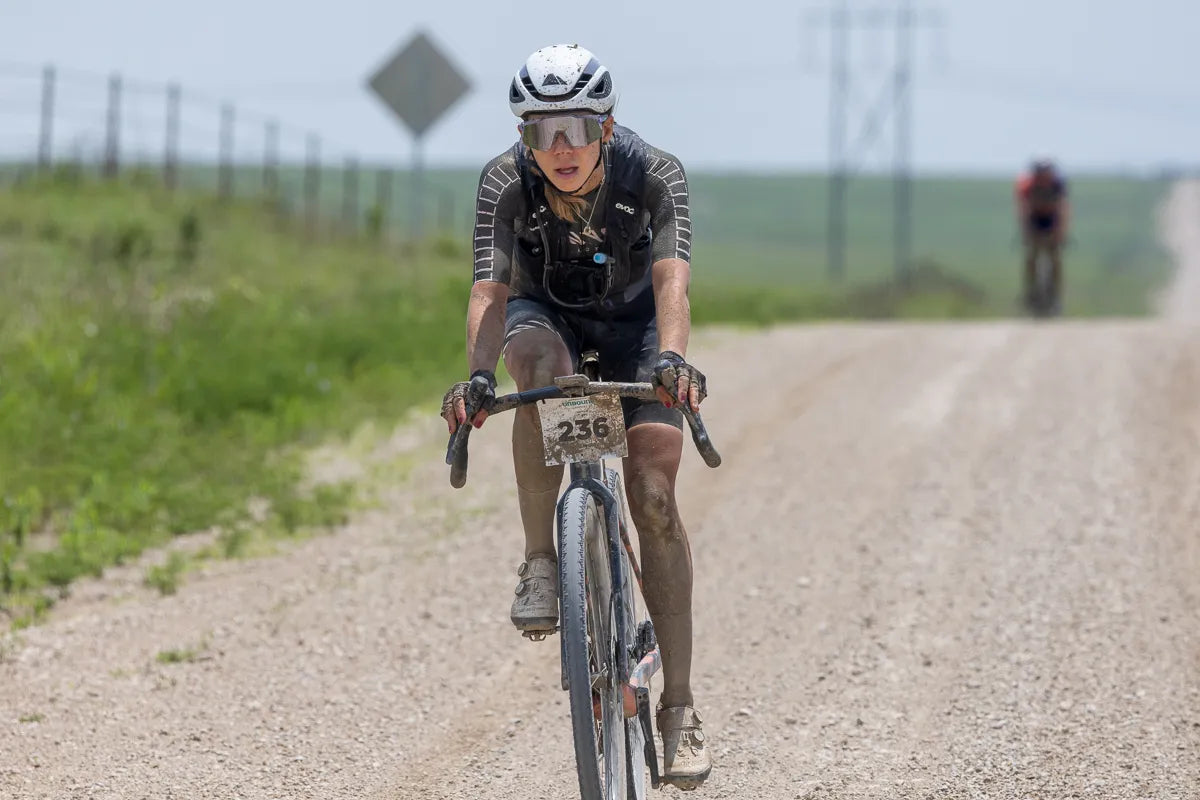
Carolin Schiff on her way to winning Unbound with the Schwalbe G-One RS. Photo: SnowyMountain Photography
At the other end of the spectrum, two of the fastest gravel tires that I think will work on loose and rough terrain are the Schwalbe G-One RS and the Continental Terra Speed. Both rank very highly in rolling resistance tests and after riding them myself, I believe the results.

Schwalbe G-One RS Super Race V-Guard Tire 700c Tubeless
$47.99
The G-One RS has won at Unbound before. It won last year under Carolin Schiff and two years ago under Ivar Slik. My main issue with the G-One RS and the Terra Speed is that they don’t last very long for me. Both seem to wear out super fast and I get less than a season on them. These tires have decent flat protection, but I’ve also managed to flat both during a regular training ride. This could have been bad luck (or bad lines) but flatting during testing has affected my confidence in them for a gnarly race like Unbound
For any super smooth or fast race, like Steamboat, either one of these tires would be my is my pick. Of the two, my favorite is the Schalwbe. It’s a semi-slick that has very little tread, but I’ve actually been super impressed with how this tire corners on loose surfaces. The transition to the side knobs is really good and I felt very confident descending on it.
My Top Unbound Gravel Tire Picks
 Challenge Getaway XPs have worked very well for me in super tough conditions.
Challenge Getaway XPs have worked very well for me in super tough conditions.
Because of my fear of punctures, my top 2 tire picks for this year are the Specialized Pathfinder Pro and Challenge Getaway XP. These tires do give up a few watts, but they’re not that much slower than the Schwalbe G-One RS and Continental Terra Speed, and they have higher puncture protection scores. Their toughness has been supported by my own experience. I’ve never managed to puncture either, even on super rough singletrack, so I have a buttload of confidence in them. They both also seem to last forever. I’ve literally never managed to wear out a pair before deciding to replace them. I’ve managed 3,000+ miles on a set of tires.

Challenge Getaway XP Handmade TLR Tubeless Tire
$94.99
The 45mm Getaway XP is what I used for all of my racing last year. I used its predecessor, the Getaway, at Unbound in 2022 to beat the sun and finish in under 13 hours. The big difference is that the XP version has some extra armor (XP = extra protection) and it’s also the easiest Challenge tire to install that I’ve ever used. Challenge tires are notorious for being hard to install. They even sell their own bead jack to help you install them. But the XP version was designed specifically to be easier to install, and I was able to get it on in seconds with my thumbs and a single tire lever. I also just really like how the Getaway corners and handles on loose terrain and in mud, and I would totally use them again.

This year, however, I’m switching to the 47mm Pathfinder Pro. It feels very similar to the Getaway XP in corners, and I’m similarly confident in its puncture protection. The big reason I’m switching to the Pathfinder is it’s about $30 cheaper per tire. When I’m buying 3 tires at a time (2 for the bike and 1 spare), that adds up.
The Pathfinder is also a proven winner. It has won Unbound multiple times before under riders like Ian Boswell and Sofia Gomez Villafane. Plus, it comes in a sexy dark tanwall version that looks good on my white bike frame while the Getaway XP only comes in black.
Do You Need Tire Inserts for Unbound Gravel?
Since losing time (and my sanity) to punctures is something I desperately want to avoid at Unbound, I am going to run tire inserts. I’ve been riding inserts for years now. They let you run lower tire pressures, which increases comfort and traction, while also providing a buffer between the tire and your rim.
 An insert could save your race. Photo: CushCore
An insert could save your race. Photo: CushCore
When you're going fast in someone’s draft or you’re just super tired, it’s really easy to accidentally smash your tire into a hole or a rock and pinch flat your tire. However, if you’re a lightweight rider or not planning to hang with any fast groups, you may not need them. My wife is 120 pounds and very conscious about taking good lines, so she didn’t feel the need for inserts at Unbound. I’m nearly 180 pounds though, and I experienced a lot of flats and broken rims in my cycling career, so I like having the extra insurance.

CushCore Gravel CX 700c Tire Insert Set
$150.00
So far I haven’t found an insert that I prefer over the CushCore gravel insert. It’s on the heavier side, about 110 grams, but the amount of protection it provides can’t be beat. I’ve liked Vittoria inserts, but they don’t have any compatible with my 45mm+ tires.
 We saw Tasman Nankervis carrying his Tubolight out after a flat last year. Shots like this make me nervous.
We saw Tasman Nankervis carrying his Tubolight out after a flat last year. Shots like this make me nervous.
For the past year, I’ve also been testing Tubolight’s gravel inserts, which are much lighter at 33 grams. They’re okay, but I just don’t have the same confidence in them that I have with CushCore. They’re really soft, and I’ve also torn a few of them just trying to remove them to swap tires, which has annoyed me.
Right now I’m planning to go back to CushCores. Remember, I don’t think the weight will matter much for a race like Unbound, plus, they’ve never let me down.
What’s the Best Tire Sealant for Unbound Gravel?
 The carbon particulates in Silca Ultimate create a "bridge" across punctures to aid sealing. Here, it sealed a ~4-5mm puncture in a Vittoria Corsa Pro and held 60 psi after, which is seriously impressive.
The carbon particulates in Silca Ultimate create a "bridge" across punctures to aid sealing. Here, it sealed a ~4-5mm puncture in a Vittoria Corsa Pro and held 60 psi after, which is seriously impressive.
The last thing I’d suggest for a solid race setup is a good tire sealant. Most of the time, I use Stan’s or Orange Seal Endurance in most of my tires, but when it’s time to race, I switch to Silca Ultimate sealant. I don’t think there’s a sealant on the market that seals punctures as well.

Silca Ultimate Tubeless Sealant
$6.99
It uses lightweight (and environmentally friendly) carbon fiber filaments that are stiffer but also much lighter than glitter or other particulates that are often added to sealants. This means they’re more mobile and more likely to get sucked toward punctures to help seal them. This combined with a super sticky foaming latex formula makes its puncture-sealing powers super effective.
I only use Silca Ultimate for racing though because it’s also kind of a pain to live with. You can’t inject it through the valve unless you buy a separate replenisher, it always makes a crazy sticky mess when I use it, I find it dries up a lot faster than Stan’s, and it clogs your valve cores super easily so you have to be really conscious about it when pumping up your tires. If you’re super paranoid about flats like me, I think it’s probably worth it, at least for race day. But if you’ve never used it, try it out ahead of time, just so you know what you’re getting into.
A Note on My Carbon Race Wheels
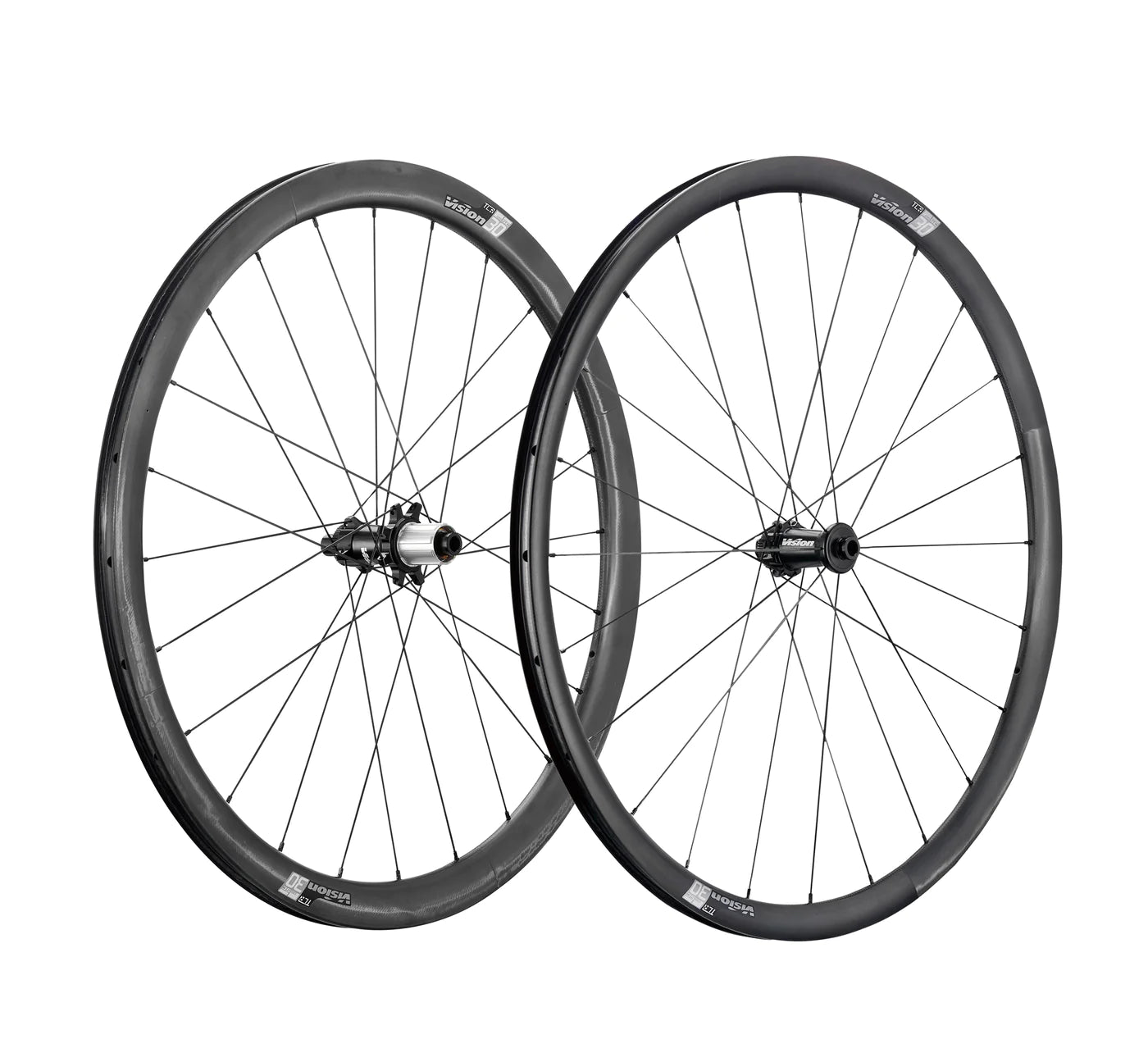
My Pathfinders are getting installed on my new race wheels — a set of Vision SC 30 AGX gravel wheels. They’re carbon, weigh 1,390 grams, and have a 23mm internal width. The rims are also hooked if that matters to you.
I don’t think carbon wheels are exactly necessary. My previous Unbounds were all done on alloy wheels. But in the quest for marginal gains this year, I'm using carbon for a bit of a performance boost. Carbon rims are lighter and stiffer than alloy, which will be the biggest benefit. Even though wide tires basically nullify wheel aerodynamics, these wheels also have a more aero shape.
These Vision wheels are also relatively affordable too (retail is $1,298.00). I’ve put in a few hundred miles on my set and like them a lot. I think TPC should start carrying them soon.
Final Thoughts
If you combine a good tire with a tire insert and some good sealant, you should have a fast, and (hopefully) flat-free gravel racing setup for Unbound. That’s what I’m expecting this year — NO flats. But no tire setup is infallible, especially when you have a heavy rock-smashing ape like me steering things. Let me know what you think! Is there a tire, insert, or sealant you like better?
